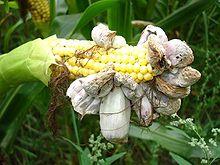Ustilaginomycotina
| Ustilaginomycotina | |
|---|---|
 |
|
| Ustilago maydis | |
| Scientific classification | |
| Kingdom: | Fungi |
| Division: | Basidiomycota |
| Subdivision: |
Ustilaginomycotina Doweld (2001) |
| Classes/orders | |
The Ustilaginomycotina is a subdivision within the division Basidiomycota of the kingdom Fungi. It consists of the classes Ustilaginomycetes and Exobasidiomycetes, and in 2014 the subdivision was reclassified and the two additional classes Malasseziomycetes and Moniliellomycetes added. The name was first published by Doweld in 2001; Bauer and colleagues later published it in 2006 as an isonym. Ustilagomycotina and Agaricomycotina are considered to be sister groups, and they are in turn sister groups to the subdivision Pucciniomycotina.
Ustilaginomycotina comprises 115 genera with more than 1700 species. The subdivision is mostly plant parasites on vascular plants, and the distribution of the subdivision is therefore restricted to the distribution of the host. The group is also called the true smut fungi because of the production of teliospores. The name smut is still used as a term since it circumscribes the organization and life cycle of Ustilaginomycotina, but it is not a taxonomic term. Ustilaginomycotina has some of the best known and studied genera of plant parasites like Ustilago and Tilletia and it is also of great economic importance.
Ustilaginomycotina is morphologically a highly diverse group. It consists of two states: anamorphic yeast state and teleomorphic filamentous smut state. These two states in the life cycle can look very different.
The Ustilaginomycotina has different ultrastructural morphologies that defines the subdivision and some of them are also used to delimit the classes in the subdivision.
...
Wikipedia
